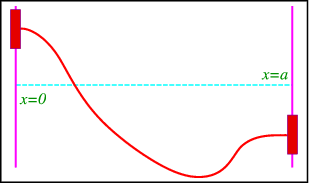5.5: More Complex Initial/Boundary Conditions
( \newcommand{\kernel}{\mathrm{null}\,}\)
It is not always possible on separation of variables to separate initial or boundary conditions in a condition on one of the two functions. We can either map the problem into simpler ones by using superposition of boundary conditions, a way discussed below, or we can carry around additional integration constants.

Let me give an example of these procedures. Consider a vibrating string attached to two air bearings, gliding along rods 4m apart. You are asked to find the displacement for all times, if the initial displacement, i.e. at t=0s is one meter and the initial velocity is x/t0 m/s.
The differential equation and its boundary conditions are easily written down,
∂2∂x2u=1c2∂2∂t2u,∂∂xu(0,t)=∂∂xu(4,t)=0,t>0,u(x,0)=1,∂∂tu(x,0)=x/t0.
What happens if I add two solutions v and w of the differential equation that satisfy the same BC’s as above but different IC’s,
v(x,0)=0,∂∂tv(x,0)=x/t0,w(x,0)=1,∂∂tw(x,0)=0?
- Answer
-
u=v+w, we can add the BC’s.
If we separate variables, u(x,t)=X(x)T(t), we find that we obtain easy boundary conditions for X(x), X′(0)=X′(4)=0,
T0(t)=A0+B0t,Tn(t)=Ancosnπ4ct+Bnsinnπ4ct,
Now impose the initial conditions
- u(x,0)=1=12A0+∞∑n=1Ancosnπ4x,which implies A0=2, An=0,n>0.
- ∂∂tu(x,0)=x/t0=12B0+∞∑n=1nπc4Bncosnπ4x.This is the Fourier sine-series of x, which we have encountered before, and leads to the coefficients B0=4 and Bn=−64n3π3c if n is odd and zero otherwise.
So finally u(x,t)=(1+2t)−64π3∑n odd1n3sinnπct4cosnπx4.


